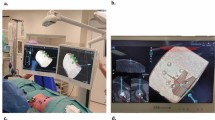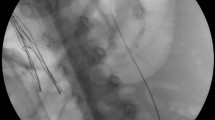Abstract
The purpose of this paper is to present our experience with real-time computed tomography (CT) fluoroscopy guided percutaneous nephrostomy (PNT) and to describe this technique involving puncture under laser guidance. We attempted 30 placements in 25 patients: puncture was directed by laser guidance and placement of the tube was made under real time CT fluoroscopy. 25 procedures were performed in prone position and 5 procedures in the supine position. The time necessary for the procedure ranged from 10 to 45 min (mean 25 min). The average duration of CT fluoroscopy per placement was 49 seconds (range 7–110 s). The PNT placement was successful as a sole procedure including puncture and catheter placement in 24 of 30 cases; in the remainder of cases, puncture was performed under CT guidance but the catheter was definitively positioned in conventional fluoroscopy. The CT fluoroscopy technique allows routine, efficient and safe PNT placement, especially when encountering difficult access to the pelvicaliceal system.
Similar content being viewed by others
References
Zegel HG, Pollack HM, Banner MP, Goldberg BB, Anger PH, Mulhern C, Kurtz A, Dubbins P, Coleman B, Koolpe H (1981) Percutaneous nephrostomy: comparison of sonographic and fluoroscopic guidance. AJR 137: 925–927
Merkle EM, Hashim M, Wendt M, Lewin JS (1999) MR-guided percutaneous nephrostomy of the nondilated upper urinary tract in a porcine model. AJR 172:1221–1225
Davidoff R, Bellman GC (1996) Influence of technique of percutaneous tract creation on incidence of renal hemorrhage. J.Urol. 157:1229–1231
Barbaric GL, Hall T, Cochran ST, Heitz DR, Schwartz RA, Krasny RM, Deseran MW (1997) Percutaneous nephrostomy: placement under CT and fluoroscopy guidance. AJR 169: 151–155
Haaga JR, Zelch MG, Alfidi RJ, Stewart BH, Daugherty JD. (1977) CT-guided antegrade pyelography and percutaneous nephrostomy. AJR 128: 621–624
Lee WJ, Mond DJ, Patel M, Pillan GP (1994) Emergency percutaneous nephrostomy:technical success based on level of operator experience. J.Vasc.Interv.Radiol. 5: 327–330
Katada K, Kato R, Anno H, Ogura Y, Koga S, Ida Y, Sato M, Nonomura K (1996) Guidance with real-time CT fluoroscopy: early clinical experience. Radiology 200: 851–856
Froelich JJ, Saar B, Hoppe M, Ishaque N, Walthers EM, Regn J, Klose KJ. (1998) Real-time CT-fluoroscopy for guidance of percutaneous drainage procedures JVIR 9: 735–740
Costello P, Gaa J (1993) Clinical assessment of an interventional CT table. Radiology 189: 284–285
Gray RR, So CB, McLoughlin RF Pugash RA, Saliken JC, Macklin NL (1996) Outpatient percutaneous nephrostomy. Radiology 198: 85–88
Author information
Authors and Affiliations
Rights and permissions
About this article
Cite this article
LeMaitre, L., Mestdagh, P., Marecatix-Delomez, J. et al. Percutaneous nephrostomy: placement under laser guidance and real-time CT fluoroscopy. Eur. Radiol. 10, 892–895 (2000). https://doi.org/10.1007/s003300051030
Received:
Revised:
Accepted:
Issue Date:
DOI: https://doi.org/10.1007/s003300051030




